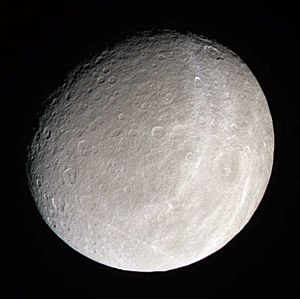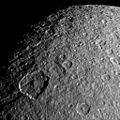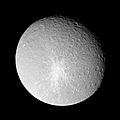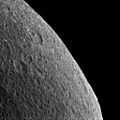Rhea (moon) facts for kids
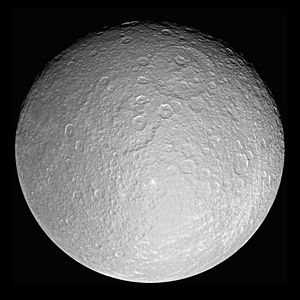
Cassini view of Rhea's anti-Saturnian hemisphere, showing the moon's two largest impact basins (Mamaldi above and left of center, and adjacent Tirawa to its upper right). At highest resolution, several long linear features are visible: halfway down from center is Harahvaiti Fossa, while near the limb left of the bottom is Koykamou Catena.
|
|||||||||
| Discovery | |||||||||
|---|---|---|---|---|---|---|---|---|---|
| Discovered by | G. D. Cassini | ||||||||
| Discovery date | December 23, 1672 | ||||||||
| Designations | |||||||||
| Saturn V | |||||||||
| Adjectives | Rhean | ||||||||
| Orbital characteristics | |||||||||
| 527 108 km | |||||||||
| Eccentricity | 0.001 258 3 | ||||||||
| 4.518 212 d | |||||||||
| Inclination | 0.345° (to Saturn's equator) | ||||||||
| Satellite of | Saturn | ||||||||
| Physical characteristics | |||||||||
| Dimensions | 1532.4×1525.6×1524.4 km | ||||||||
|
Mean radius
|
763.8 ± 1.0 km | ||||||||
| 7 337 000 km² | |||||||||
| Mass | (2.306 518 ± 0.000 353)×1021 kg (~3.9×10−4 Earths) | ||||||||
|
Mean density
|
1.236 ± 0.005 g/cm³ | ||||||||
| 0.265 m/s² | |||||||||
| 0.635 km/s | |||||||||
| 4.518 212 d (synchronous) |
|||||||||
| zero | |||||||||
| Albedo | 0.949 ± 0.003 (geometric) | ||||||||
|
|||||||||
| 10 | |||||||||
Rhea (Ancient Greek: Ῥέᾱ) is Saturn's second largest moon. It is made of ice and rock.
Contents
Discovering Rhea
Rhea was first seen by an astronomer named Giovanni Domenico Cassini. He discovered this moon on December 23, 1672. Cassini used a telescope to find Rhea orbiting Saturn.
Rhea's Place in Space
Rhea orbits Saturn at a distance of about 527,108 kilometers. It takes Rhea about 4.5 Earth days to go around Saturn once. This is also how long it takes Rhea to spin once. This means Rhea always shows the same side to Saturn, just like our Moon does to Earth. This is called tidal locking.
Rhea is mostly made of ice, with some rock mixed in. It is a very cold place, with temperatures as low as 53 K (which is -220 degrees Celsius or -364 degrees Fahrenheit).
Rhea's Surface
Rhea's surface is covered in many craters. These are like big bowls made when space rocks hit the moon. Some of these craters are very large. The moon also has long, thin lines called fossae and catenae. These might be cracks in the ice.
Could Rhea Have Rings?
Scientists think Rhea might have its own thin ring system. If true, these would be the first rings ever found around a moon. The rings would be made of tiny pieces of ice and dust.
The idea of Rhea having rings was announced in a science journal in 2008. Spacecraft like Cassini have studied Rhea closely to learn more about this possibility.
Images for kids
-
Giovanni Domenico Cassini, who found Rhea in 1672.
See also
 In Spanish: Rea (satélite) para niños
In Spanish: Rea (satélite) para niños


